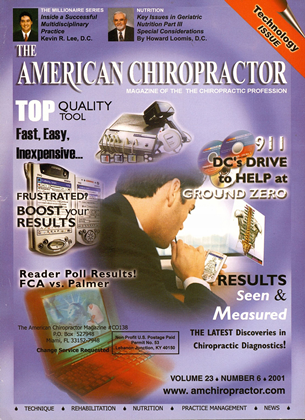A little less than 100 years ago, D. D. Palmer stated that trauma, poison/toxins, and autosuggestion were the cause of disease. Most of us learned about this in chiropractic college. Almost 20 years ago, I sat in my first trimester Chiropractic Principles class and was taught that trauma, toxins, and autosuggestion cause disease and subluxation. Palmer never went on to outline how these three factors act to promote disease or dysfunction, and he never described the substances that act as toxins. Of course, "toxins" represent an enormous category of potential agents, encompassing a wide array of environmental pollutants, natural substances, and microorganisms. I prefer to view "toxins" from a metabolic perspective and, therefore, consider the chemical mediators of inflammation and nociception to be toxins. Numerous substances are known to drive the inflammatory process and irritate nociceptors, such as prostag-landin E.,, bradykinin, 5-hydrox-ytryptamine. histamine, leukotriene B4, and certain cytokines. Inflammation and nociceptive input that alterjoint function are the likely promoters of joint dysfunction or subluxa-tion. Several years ago, pharmacological research showed that NSAID's could reduce pain and tenderness, and increase spine motion. To me, this represents a pharmacological adjustment, as increased motion is one of the outcomes. NSAID's promote unwanted side effects, however, and should be avoided, if possible. Instead, I look to nutritional supplements for the same benefits. In fact, certain nutritional supplements act as natural NSAID's, providing for a nutritional adjustment, if you will. In my experience, ginger may be the most potent natural inhibitor of inflammation and nociception, providing dra- matic relief of pain, stiffiiess, and improving joint motion—which represents a nutritional adjustment. Essentially, ginger functions as a natural COX-2 inhibitor, without the side effects. Other nutritional substances can also reduce nocicep-tion, inflammation, and I will talk about more of them in future columns. I chose to, first, focus on ginger, be- cause it is an extremely safe supplement, widely available, and generally very inexpensive. Any patient who can afford your services can also afford to take ginger. Typical retail prices range from $5 to $9 per bottle of 90-to-100 capsules. In the next issue, I will describe some of the research devoted to ginger; but, for now, consider a brief account of one interesting study. Researchers in Den- mark interviewed 56 patients who were self-treating with ginger.1 The patients suffered with rheumatoid arthritis (RA), osteoarthritis, or muscular aches and pains. A significant number of patients experienced a dramatic reduction in pain and swelling following the consumption of ginger. Better results seemed to occur in those who took the most ginger. For example, one man was diagnosed with RA at the age of 50. He began taking 50 grams of raw/fresh ginger daily in the first month after diagnosis. The ginger was lightly cooked and added to vegetable and meat dishes. Within one month, relief of pain and swelling was evident; and, at three months, the patient was completely free of pain and swelling. Remarkably, at the time of interview, 13-14 years had passed without a relapse of symptoms. We all know that NSAID's can damage the gut, liver, kidneys and joints. On the contrary, ginger appears to be free of such dangerous side effects. One of the interviewees was an 80-year-old woman who suffered with osteoarthritis. She, also, had but one kidney; so, if ginger consumption had the potential to produce side effects, this woman would be a likely candidate. As it turns out, she had been taking ginger for 3 years at the time of the interview. For the first 6 months, she took 6 grams of powdered ginger per day, which was, then, reduced to approximately 2 grams per day. Her arthritis symptoms were relieved and she did not experience any side effects. I recommend ginger to all who suffer from aches and pains. I suggest that people try to take 6 grams per day for the first week-to-month, which amounts to about 12 capsules per day. Thereafter, 2 grams per day seems to maintain relief. After relief of pain is achieved, I suggest maintaining a daily dose of 1-2 grams. This is because ginger offers many heath-promoting effects beyond inhibition of inflammation and nociception, some of which will be discussed in the next issue of TAC. Try using ginger in your practice; you won't be sorry. You and your patients will love the benefits of getting a nutritional adjustment. David Seaman can be contacted at 4326 Market St., Ste. #100 Wilmington, NC 28403, and by phone at 910-342-0133. His e-mail address is doc(a)LessPainBetterGolf.com References 1. Srivastava KC. Mustafa T. "Ginger (Zingibcr officinale) in rheumatism and muscu-loskeletal disorders". Metl Hyp 1992; 39:342-48.
 View Full Issue
View Full Issue









